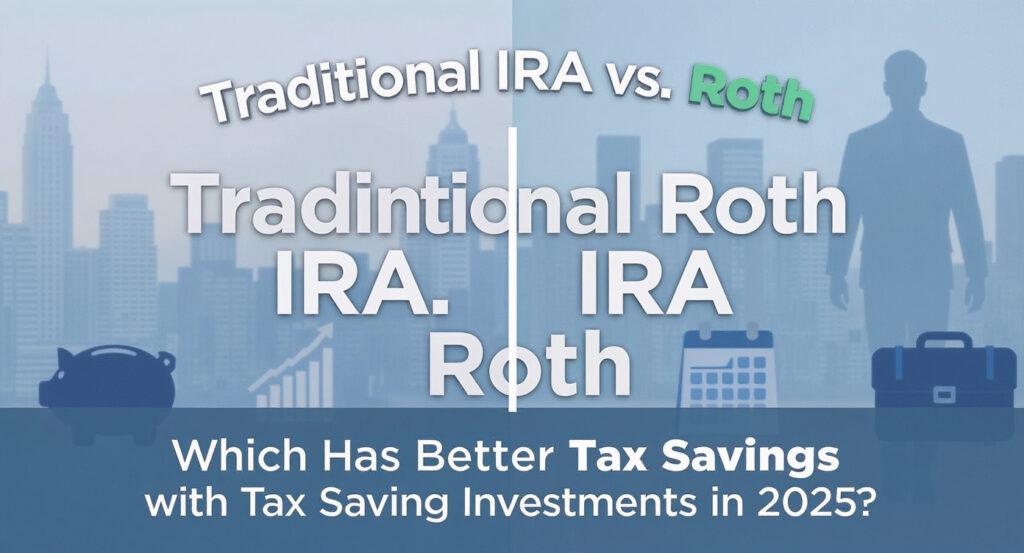
Saving for retirement is one of the most important financial steps people can take. But it isn’t always easy to figure out the best way to do it. Two popular retirement accounts, the Traditional IRA and the Roth IRA, give people special tax benefits that help their money grow over time. Choosing between the two often comes down to one key question: Which account offers better tax savings when you make tax saving investments?
This article will explain the differences between a Traditional IRA and a Roth IRA, show how tax savings work in each account, and help you think about which option may be better for you in 2025.
What Is a Traditional IRA?
A Traditional IRA is a retirement savings account that lets you put in money before taxes are taken out. This means the amount you contribute lowers your taxable income for the year. For example, if you earn $50,000 and contribute $6,000 to a Traditional IRA, you may only be taxed as if you earned $44,000. This can save you money on taxes right now.
However, the IRS will eventually collect taxes when you take money out in retirement. All withdrawals from a Traditional IRA are taxed as regular income. That includes both your original contributions and the investment growth.
In other words, a Traditional IRA gives you tax savings today, but you’ll pay taxes later. This is important to remember when comparing it with the Roth IRA.
What Is a Roth IRA?
A Roth IRA works in the opposite way. You contribute money after paying taxes on it. This means you don’t get an immediate tax break when you invest. If you earn $50,000 and put $6,000 into a Roth IRA, you’ll still be taxed on the full $50,000 that year.
But the big benefit comes later: when you retire, all withdrawals from a Roth IRA are tax-free. That includes both your contributions and all the growth from your investments.
So, the Roth IRA gives you tax savings in the future, instead of today. This is a powerful tool for people who expect their income and their tax rates to be higher later in life.
How Do Tax Savings Differ When You Invest in Tax Saving Investments Between These Two Accounts?
When comparing the Traditional IRA vs. Roth, the main difference lies in when you get the tax savings.
- Traditional IRA: You save money on taxes now, but you’ll owe taxes when you take out the money in retirement.
- Roth IRA: You pay taxes now, but you’ll save money later because withdrawals are tax-free.
Let’s say you put $5,000 into each account and it grows to $20,000 over the years.
- If that $20,000 is in a Traditional IRA, you will owe income taxes on it when you withdraw the money.
- If it’s in a Roth IRA, you’ll pay no taxes when withdrawing; the entire $20,000 is yours to keep.
This difference matters a lot when you’re thinking about which account works best for your tax saving investments.
Who Benefits More from a Traditional IRA?
A Traditional IRA might be better for people who:
- Want immediate tax savings – If you need a tax break now, this account lowers your taxable income right away.
- Expect to have a lower income in retirement – If you think your tax rate will be lower later, paying taxes in the future may be cheaper than paying them now.
- Earn too much to qualify for a Roth IRA – There are income limits for Roth IRAs. If you make too much money, you may not be eligible to contribute directly.
For example, if someone is in a high tax bracket today but expects to be in a lower bracket after retiring, the Traditional IRA could save them more money overall.
Who Benefits More from a Roth IRA?
A Roth IRA might be better for people who:
- Expect higher income in retirement – If your tax rate will be higher later, it makes sense to pay taxes now while rates are lower.
- Want tax-free growth – Once money is inside a Roth IRA, it grows without future tax bills. This can make a big difference over decades of investing.
- Prefer flexibility – Roth IRAs allow you to withdraw your original contributions (not the earnings) at any time without penalty.
For example, a young worker who is just starting their career and expects to earn much more later may find that a Roth IRA provides the most long-term benefit for tax saving investments.
The Role of Tax Saving Investments
No matter which account you choose, the type of investments you pick also plays a big role in your tax savings. Stocks, bonds, mutual funds, and index funds can all grow inside both Traditional and Roth IRAs without being taxed each year.
The key difference is simply when you pay taxes:
- With a Traditional IRA, you delay paying taxes until you withdraw.
- With a Roth IRA, you pay taxes upfront, then enjoy tax-free withdrawals.
This means that if your investments grow a lot, a Roth IRA could provide more tax savings in the long run because you’ll never owe taxes on that growth.
Traditional IRA vs. Roth in 2025: What Should You Choose?
Choosing between a Traditional IRA and a Roth IRA in 2025 depends on your personal situation:
- If you’re focused on immediate tax relief, a Traditional IRA might be the better fit.
- If you want long-term tax-free income in retirement, a Roth IRA could be the smarter choice.
- Some people even split their contributions between both accounts, which helps balance tax savings now and later.
When thinking about your own retirement, it’s wise to ask: Do I want to save money on taxes today, or do I want to save money on taxes in the future?
Final Thoughts
The debate of Traditional IRA vs. Roth often comes down to timing. Both accounts offer powerful ways to build wealth and take advantage of tax saving investments. In 2025, with tax laws and personal incomes changing, the right choice may look different for each person.
If you want immediate relief, the Traditional IRA can lower your taxable income now. If you want tax-free growth for decades to come, the Roth IRA may be the better choice. Either way, the most important step is to start saving and let time and compound growth work in your favor.


